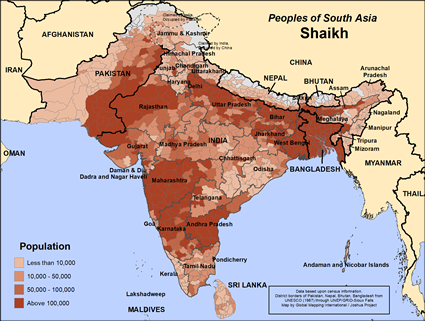Islam arrived in the area now known as Pakistan in 711 AD when a Muslim Arab Army conquered the northwestern part of the Indus Valley from Jammu and Kashmir to the Arabian Sea. Technocrats, bureaucrats, soldiers, traders, scientists, architects, teachers, theologians and sufis flocked from the rest of the Arab and Muslim world, to the Islamic Sultanate in South Asia and settled permanently.
The descendants of these Arabs usually go by the title of Shaikh. Shaikh is also a term that is usually attributed to the leaders or elders of Arabian social groups. Other variants of this term are Sheik, Shaykh, Shaikh, Cheikh, Šeih, Šejh, Seyh.
After the advent of Islam in South Asia, some high caste (Brahmans, Muslim Rajputs and Khatris) converted to Islam in the Punjab region and adopted this title. They are known as Punjabi Shaikh (Punjabi).
Though the vast majority of Shaikhs are either in Bangladesh or India or Pakistan, there is a smaller number in Nepal and Bhutan.
The Shaikhs are not bound by one particular profession. The Shaikh can be broadly grouped into five communities. Three of these communities are the Siddiks, Farukis and Abbasi who are often descendants of Arab immigrants. The other two are the Chistis and Kuraishis communities who tend to be mainly from converts to Islam. Consequently, Shaikhs profess Islam and have both Sunni and Shia traditions among them.
In Nepal they speak Nepali and either Urdu, Bhojpuri or Maithili, in their communities. They are not vegetarian and their common food is rice, mutton and vegetables. Common surnames are Mondal, Siddiqui, Usmani, Faroqui and Sheikh.
It is likely that the Shaikhs in Bhutan do not hold the high status that they do in other South Asian countries, since they are Muslims. Bhutan is primarily Tibetan Buddhist.
Shaikhs are among the more orthodox Sunni Muslims. They have high status, and Muslims look to them as leaders, and as examples to follow.
There has been much ministry activity among the Shaikh in India but few works in Nepal. Pray that this largest group of Nepali Muslims will find the truth of the Prophet Isa! There is a lot of potential for gospel growth within the Shaikh community because of relatively few social divisions.
Pray that the Shaikhs in Bhutan will understand that they need a Savior, who is none other than Jesus Christ.
Since there are few ways for the gospel to get to these Muslims in a Buddhist country, pray that the Lord reveals himself to Shaikhs in unusual ways such as dreams and visions.
Pray that the Holy Spirit will touch the hearts of Shaikhs to study the Injil (New Testament) and learn to pattern their lives after Jesus.
Scripture Prayers for the Shaikh in Bhutan.
https://joshuaproject.net/people_groups/18084/IN
https://joshuaproject.net/people_groups/18084/NZ
https://en.wikipedia.org/wiki/Shaikhs_in_South_Asia
http://www.globalprayerdigest.org/index.php/issue/day/Shaikhs-in-India-and-Bangladesh/
| Profile Source: Keith Carey |












